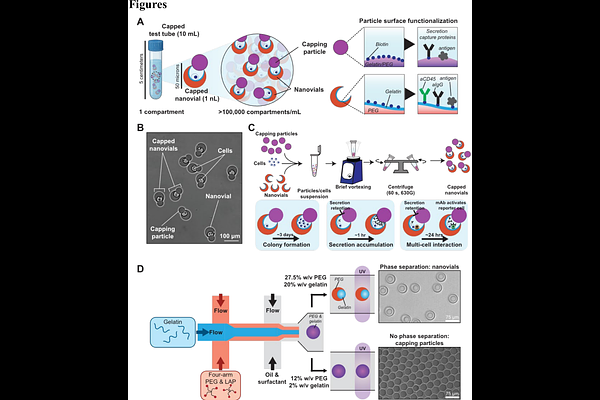Sealable capped nanovials for high-throughput screening of cell growth and function

Sealable capped nanovials for high-throughput screening of cell growth and function
Mellody, M. P.; Nakagawa, Y.; Arnheim, A.; Shang, L.; Soo, C.; Tsubamoto, N.; Taylor, S.; Shastry, S.; Luk, W.; Morales, I.; James, R.; Di Carlo, D.
AbstractMillions of modular nanoliter-scale compartments that isolate functionally rich single-cell and cell-to-cell communication data can scale biological discovery for the age of AI. Here, we introduce capped nanovials; suspendable, sealable microscale compartments formed by the docking of hydrogel capping particles into bowl-shaped nanovials as a versatile system for culturing, analyzing, and sorting single cells and small colonies. This two-particle architecture enables localized confinement of cells and secreted products while maintaining compatibility with standard laboratory workflows such as wash and reagent exchange steps, fluorescence microscopy, and flow cytometry. Crucially, these compartments are formed via simple pipetting and centrifugation steps, making the platform highly democratized. We demonstrate the ability of capped nanovials to compartmentalize single mammalian, bacterial, and yeast cells and support growth into colonies, enabling selection based on proliferation and bioproduction. We further show that capped nanovials enhance single-cell secretion assays by reducing molecular crosstalk and increasing signal-to-noise ratios. Importantly, we demonstrate functional co-culture assays by permitting stable confinement of cell pairs, enabling detection and enrichment of antibody-secreting cells based on the ability of their secreted antibodies to activate co-encapsulated reporter T cells, achieving a signal-to-noise ratio of >30 and up to 100% selection purity. By combining the simplicity of standard lab handling with the resolution and throughput of traditional microfluidic compartmentalization approaches, capped nanovials provide a new class of scalable, accessible test tubes for modern single-cell biology.